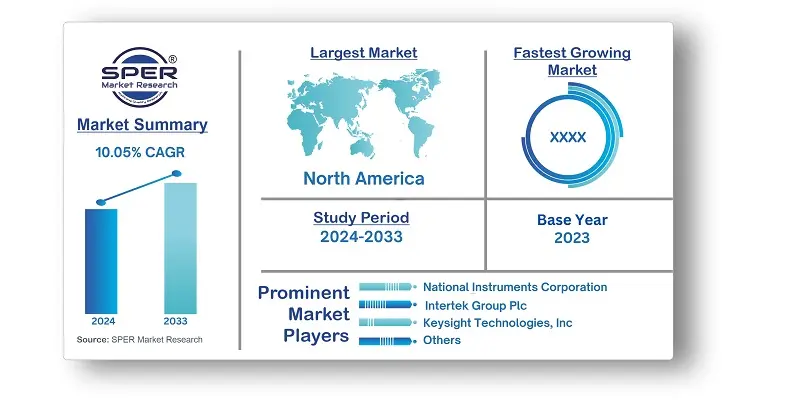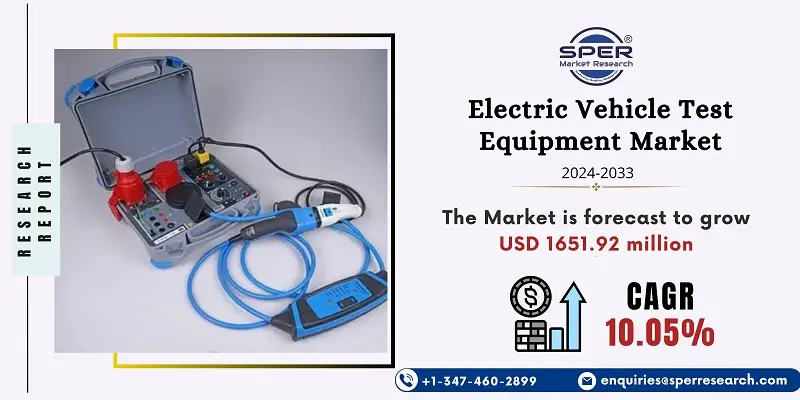
Electric Vehicle Test Equipment Market Trends, Share, Size, Demand, Revenue and Future Outlook
Electric Vehicle Test Equipment Market Growth, Size, Trends Analysis- By Vehicle, By Fuel, By Application- Regional Outlook, Competitive Strategies and Segment Forecast to 2033
| Published: Nov-2024 | Report ID: AMIN24241 | Pages: 1 - 237 | Formats*: |
| Category : Automotive & Transportation | |||
- March 2023; Unico released the Quantum Drive Platform to help electric car battery manufacturers create and validate products faster, with lower installation and operating costs. The system incorporates several battery packs, modules, and cell test channels, enabling for more cost-effective and efficient testing of Alternating Current (AC) and Direct Current (DC) outputs.
- June 2024; HORIBA launched its STARS Battery software, which aims to improve battery testing skills in the mobility market. This new program allows for the testing of a variety of battery types, including single cells, modules, and packs, as well as performance and durability tests, which are critical for assuring the reliability of electric propulsion systems.


| Report Metric | Details |
| Market size available for years | 2020-2033 |
| Base year considered | 2023 |
| Forecast period | 2024-2033 |
| Segments covered | By Vehicle, By Fuel, By Application |
| Regions covered | North America, Asia-Pacific, Latin America, Middle East & Africa and Europe |
| Companies Covered | National Instruments Corporation, Intertek Group Plc, Keysight Technologies, Inc, Tuv Rheinland, Durr Group, AVL, Chroma ATE. |
- Automotive Manufacturers
- Battery Manufacturers
- Automotive Component Suppliers
- Research & Development (R&D) Institutes
- Government Agencies and Regulatory Bodies
- Third-Party Testing and Certification Companies
| By Vehicle: | |
| By Fuel: | |
| By Application: |
- Global Electric Vehicle Test Equipment Market Size (FY’2024-FY’2033)
- Overview of Global Electric Vehicle Test Equipment Market
- Segmentation of Global Electric Vehicle Test Equipment Market by Vehicle (Passenger car, Commercial vehicle)
- Segmentation of Global Electric Vehicle Test Equipment Market by Fuel (Battery Electric Vehicles, Plug-in Hybrid Electric Vehicles, Hybrid Electric Vehicles)
- Segmentation of Global Electric Vehicle Test Equipment Market by Application (EV component, EV charging, Powertrain, Battery test, Others)
- Statistical Snap of Global Electric Vehicle Test Equipment Market
- Expansion Analysis of Global Electric Vehicle Test Equipment Market
- Problems and Obstacles in Global Electric Vehicle Test Equipment Market
- Competitive Landscape in the Global Electric Vehicle Test Equipment Market
- Impact of COVID-19 and Demonetization on Global Electric Vehicle Test Equipment Market
- Details on Current Investment in Global Electric Vehicle Test Equipment Market
- Competitive Analysis of Global Electric Vehicle Test Equipment Market
- Prominent Players in the Global Electric Vehicle Test Equipment Market
- SWOT Analysis of Global Electric Vehicle Test Equipment Market
- Global Electric Vehicle Test Equipment Market Future Outlook and Projections (FY’2024-FY’2033)
- Recommendations from Analyst
1.1. Scope of the report1.2. Market segment analysis
2.1. Research data source2.1.1. Secondary Data2.1.2. Primary Data2.1.3. SPER’s internal database2.1.4. Premium insight from KOL’s2.2. Market size estimation2.2.1. Top-down and Bottom-up approach2.3. Data triangulation
4.1. Driver, Restraint, Opportunity and Challenges analysis4.1.1. Drivers4.1.2. Restraints4.1.3. Opportunities4.1.4. Challenges4.2. COVID-19 Impacts of the Global Electric Vehicle Test Equipment Market.
5.1. SWOT Analysis5.1.1. Strengths5.1.2. Weaknesses5.1.3. Opportunities5.1.4. Threats5.2. PESTEL Analysis5.2.1. Political Landscape5.2.2. Economic Landscape5.2.3. Social Landscape5.2.4. Technological Landscape5.2.5. Environmental Landscape5.2.6. Legal Landscape5.3. PORTER’s Five Forces5.3.1. Bargaining power of suppliers5.3.2. Bargaining power of buyers5.3.3. Threat of Substitute5.3.4. Threat of new entrant5.3.5. Competitive rivalry5.4. Heat Map Analysis
6.1. Global Electric Vehicle Test Equipment Market Manufacturing Base Distribution, Sales Area, Product Type6.2. Mergers & Acquisitions, Partnerships, Product Launch, and Collaboration in Global Electric Vehicle Test Equipment Market
7.1. Global Electric Vehicle Test Equipment Market Size, Share and Forecast, By Vehicle, 2020-20267.2. Global Electric Vehicle Test Equipment Market Size, Share and Forecast, By Vehicle, 2027-20337.3. Passenger car7.4. Commercial vehicle
8.1. Global Electric Vehicle Test Equipment Market Size, Share and Forecast, By Fuel, 2020-20268.2. Global Electric Vehicle Test Equipment Market Size, Share and Forecast, By Fuel, 2027-20338.3. Battery Electric Vehicles (BEVs)8.4. Plug-in Hybrid Electric Vehicles (PHEVs)8.5. Hybrid Electric Vehicles (HEVs)
9.1. Global Electric Vehicle Test Equipment Market Size, Share and Forecast, By Application, 2020-20269.2. Global Electric Vehicle Test Equipment Market Size, Share and Forecast, By Application, 2027-20339.3. EV component9.4. EV charging9.5. Powertrain9.6. Battery test9.7. Others
10.1. Global Electric Vehicle Test Equipment Market Size and Market Share
11.1. Global Electric Vehicle Test Equipment Market Size and Market Share By Region (2020-2026)11.2. Global Electric Vehicle Test Equipment Market Size and Market Share By Region (2027-2033)11.3. Asia-Pacific11.3.1. Australia11.3.2. China11.3.3. India11.3.4. Japan11.3.5. South Korea11.3.6. Rest of Asia-Pacific11.4. Europe11.4.1. France11.4.2. Germany11.4.3. Italy11.4.4. Spain11.4.5. United Kingdom11.4.6. Rest of Europe11.5. Middle East and Africa11.5.1. Kingdom of Saudi Arabia11.5.2. United Arab Emirates11.5.3. Qatar11.5.4. South Africa11.5.5. Egypt11.5.6. Morocco11.5.7. Nigeria11.5.8. Rest of Middle-East and Africa11.6. North America11.6.1. Canada11.6.2. Mexico11.6.3. United States11.7. Latin America11.7.1. Argentina11.7.2. Brazil11.7.3. Rest of Latin America
12.1. NATIONAL INSTRUMENTS CORPORATION12.1.1. Company details12.1.2. Financial outlook12.1.3. Product summary12.1.4. Recent developments12.2. INTERTEK GROUP PLC12.2.1. Company details12.2.2. Financial outlook12.2.3. Product summary12.2.4. Recent developments12.3. KEYSIGHT TECHNOLOGIES, INC12.3.1. Company details12.3.2. Financial outlook12.3.3. Product summary12.3.4. Recent developments12.4. TUV RHEINLAND12.4.1. Company details12.4.2. Financial outlook12.4.3. Product summary12.4.4. Recent developments12.5. DURR GROUP12.5.1. Company details12.5.2. Financial outlook12.5.3. Product summary12.5.4. Recent developments12.6. AVL12.6.1. Company details12.6.2. Financial outlook12.6.3. Product summary12.6.4. Recent developments12.7. CHROMA ATE12.7.1. Company details12.7.2. Financial outlook12.7.3. Product summary12.7.4. Recent developments12.8. Others
SPER Market Research’s methodology uses great emphasis on primary research to ensure that the market intelligence insights are up to date, reliable and accurate. Primary interviews are done with players involved in each phase of a supply chain to analyze the market forecasting. The secondary research method is used to help you fully understand how the future markets and the spending patterns look likes.
The report is based on in-depth qualitative and quantitative analysis of the Product Market. The quantitative analysis involves the application of various projection and sampling techniques. The qualitative analysis involves primary interviews, surveys, and vendor briefings. The data gathered as a result of these processes are validated through experts opinion. Our research methodology entails an ideal mixture of primary and secondary initiatives.



Frequently Asked Questions About This Report
PLACE AN ORDER
Year End Discount
Sample Report
Pre-Purchase Inquiry
NEED CUSTOMIZATION?
Request CustomizationCALL OR EMAIL US
100% Secure Payment






Related Reports
Our Global Clients
Our data-driven insights have influenced the strategy of 200+ reputed companies across the globe.




















